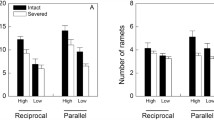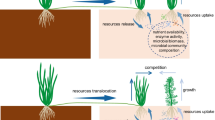Summary
The selection pressures experienced by clonal plants in heterogeneous environments may be significantly affected by physiological integration among ramets via rhizome connections. We experimentally examined how connections affected the response to saline soil conditions in Ambrosia psilostachya clones from natural saline basins in eastern Nebraska. Paired stems connected by uniform lengths of rhizome were grown in partitioned pots in 3 watering regimes: (1) both stems watered with tapwater, (2) both stems watered with salt water (1% NaCl), and (3) one stem watered with salt water and one with tapwater. All plants survived and grew in salt water, yet dry weight gain of salt-salt plants was only 34% of that for plants in uniform tapwater. Salt plants connected to tapwater plants had 2-fold higher dry weight gain than salt-salt plants. Their tapwater neighbors had significantly smaller biomass than pairs with both stems growing in tapwater. Measurements of leaf stomatal conductance, transpiration rate and water potential, together with root-shoot allocation patterns, suggest that rhizomes transported both water and photosynthate from tapwater plants to their neighbors in saline soil. These results indicate that ramets in a locally inferior environment can be helped by their neighbors, but at some cost to the contributing ramet. We discuss the consequences of this phenomenon for the evolution of local adaptation in populations of rhizomatous plants.
Similar content being viewed by others
References
Anonymous (1980) Soil survey of Lancaster County, Nebraska. United States Department of Agriculture, Soil Conversation Service. University of Nebraska, Conservation and Survey Division. Lincoln, Nebraska
Ashmun JW, Thomas RJ, Pitelka LF (1982) Translocation of photoassimilates between sister ramets in two rhizomatous forest herbs. Ann Bot 49:403–415
Aston JL, Bradshaw AD (1966) Evolution in closely adjacent plant populations. II. Agrostis stolonifera in maritime habitats. Heredity 21:649–664
Bradshaw AD (1972) Some of the evolutionary consequences of being a plant. Evol Biol 5:25–47
Chabot BF, Bunce JA (1979) Drought stress effects on leaf carbon balance. In: Solbrig OT, Jain S, Johnson GB, Raven PH (eds) Topics in plant population biology. Columbia Univ Press, pp 338–355
Hansen DJ, Dayanandan P, Kaufman PB, Brotherson JD (1975) Ecological adaptations of salt marsh grass, Distichlis spicata (Gramineae), and environmental factors affecting its growth and distribution. Amer J Bot 63:635–650
Hartnett DC, Bazzaz FA (1983) Physiological integration among intraclonal ramets in Solidago canadensis. Ecology 64:779–788
Kister LR, Mundorff JC (1963) Sedimentation and chemical quality of water in Salt Creek Basin Nebraska. Geological Survey Water-Supply Paper 1669-H. United States Government Printing Office, Washington DC
Lynch M, Gabriel W (1983) Phenotypic evolution and parthenogenesis. Amer Natur 122:745–764
Mooring MT, Cooper AW, Seneca ED (1971) Seed germination response and evidence for height ecophenes in Spartina alterniflora from North Carolina. Amer J Bot 58:48–55
Newell SJ (1982) Translocation of 14C-photoassimilate in two stoloniferous Viola species. Bull Torrey Bot Club 109:306–317
Noble JC, Marshall C (1983) The population biology of plants with clonal growth. II. The nutrient strategy and modular physiology of Carex arenaria. J Ecology 71:865–877
Richards LA (1954) Diagnosis and improvement of saline and alkaline soils. Agricultural Handbook No 60. United States Department of Agriculture. United States Government Printing Office, Washington DC
Schaffner JH (1898) Notes on the salt marsh plants of northern Kansas. Bot Gazette 25:255–260
Snedecor GW, Cochran WG (1980) Statistical methods, seventh edition. Iowa State Univ Press, Ames, Iowa
Turkington R, Harper JL (1979) The growth, distribution and neighbor relationships of Trifolium repens in a permanent pasture. IV. Fine-scale biotic differentiation. J Ecology 67:247–254
Ungar IA (1965) An ecological study of the vegetation of the Big Salt Marsh, Stafford County, Kansas. Univ Kansas Science Bull 46:1–98
Ungar IA, Hogan W, McClelland M (1969) Plant communities of saline soils at Lincoln, Nebraska. Amer Midl Natur 82:564–577
Author information
Authors and Affiliations
Rights and permissions
About this article
Cite this article
Salzman, A.G., Parker, M.A. Neighbors ameliorate local salinity stress for a rhizomatous plant in a heterogeneous environment. Oecologia 65, 273–277 (1985). https://doi.org/10.1007/BF00379229
Received:
Issue Date:
DOI: https://doi.org/10.1007/BF00379229




